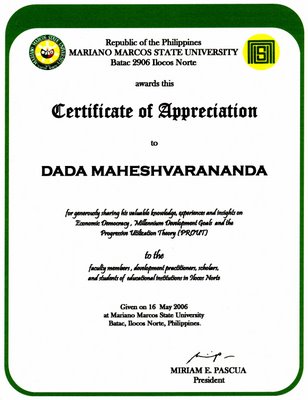
When I landed in Manila International Airport last week, the customs officer asked me if I had anything to declare. “Yes,” I said. “I declare that I am very happy to be back after 16 long years!” She looked at me and said, “I bet you looked different then, without your white hair.” “Yes, ma’am, that’s a fact!”
I had worked in Manila from 1981-1990, so this time I met dozens of old friends, and adults came up to me and told me I had performed their baby-naming ceremony! It was truly wonderful to see again the spirit of Bayanihan, the Tagalog word which means to move a house together. This is the spirit of solidarity, of making the impossible become possible (painting by Joselito E. Barcelona, 1993).
Of course I wasn’t happy about every change that had taken place. The World Bank reports that air pollution kills 2,000 Filipinos a year. In addition, in the cities of Metro Manila, Cebu, Davao and Baguio 9,000 suffer chronic bronchitis. Lost wages and medical treatment total Pesos 79.5 billion (US$1.5 billion) annually, 2 percent of the gross domestic product (GDP). This means that every Filipino spends around P 2,000 ($40) each year for treatment and medication for illnesses caused by air pollution.
Automobiles create 80 percent of the pollution, reducing everyone’s life expectancy. Tiny particles (“particulate matter”) penetrate deep into respiratory tissue and directly into the bloodstream. The good news is that eating more fresh fruits and vegetables help to reduce the creation of “free radicals” in the body caused by this particulate matter.
Deforestation has also worsened. From 1980 to 2000 the total forest coverage in Maharlika was reduced by half! Today only 19 percent of the country is covered by forest. The tragic results are land degradation, erosion, flash floods, draught and mudslides. (Ian Coxhead and Sisira Jayasuriya, “Environment and Natural Resources” in The Philippine Economy: Development, Policies and Challenges, Oxford University Press, 2003.)
The West prides itself on its science and technology, yet it ignores the warnings of world scientists about the effects of pollution and global warming. First in 1992, scientists from around the world signed a joint letter asking world leaders to sign the global warming treaty at Kyoto. Five years later even more signed a "Call to Action"– 1,500 scientists from 63 countries, including 110 Nobel Prize laureates. Then in 2001, 100 Nobel laureates issued a brief but dire warning of the profound dangers facing the world from global warming and the proliferation of small arms: “…To survive in the world we have transformed, we must learn to think in a new way. As never before, the future of each depends on the good of all.”
Predictably, these compelling warnings have been for the most part ignored by the mainstream media in the United States because they are contrary to the policies of the US government.
I checked the Forbes magazine website (www.forbes.com) to see who are the richest Filipinos – as expected, the three billionaires were also the wealthiest people 20 years before:
- Lucio Tan, self-made wealth from cigarettes, liquor, Philippine Airlines and Philippine National Bank. Total worth: US$ 1.7 billion.
- Henry Sy & family, self-made, owns 23 shopping malls: US$1.5 billion.
- Jaime Zobel de Ayala & family, inherited, Ayala Corporation owns real estate, water and telecom: US$1.3 billion.
By checking the Forbes lists during the last ten years, it can seen that each one is two to three times richer. So I asked each audience, “Are you?” Invariably the reply came, “No, we’re poorer!”
Professor Arsenio M. Balisacan of the University of the Philippines in his article “Poverty and Inequality” in The Philippine Economy: Development, Policies and Challenges, Oxford University Press, 2003 gives many statistics demonstrating how the widening gap between rich and poor has resulted in most of the gains of national economic growth being eaten up by the rich, leaving the poor with very little benefit.
Of course Prout’s response to this extraordinary widening gap between rich and poor is to remind everyone that the world’s physical resources are limited. If individuals accumulate too much, there will not be enough for everyone. So every country should decide maximum salaries, wealth and land ownership. The only reason to pay more is to motivate people to make a greater effort to benefit society.
I had the pleasure of meeting again Alejandro Lichauco, a radical economist cited in the bibliography of my book. His most recent work is Hunger, Corruption and Betrayal: A Primer on U.S. Neocolonialism and the Philippine Crisis, Citizen’s Committee on the National Crisis (CCNC), 2005, 115 pages, available online for $12.00 from www.marymartin.com. He writes on Thursdays and Sundays for The Daily Tribune and many of his articles can be found online by doing a Google search. He was imprisoned for three months and then kept under house arrest for two years by former dictator Ferdinand Marcos. In an “Open letter to President Gloria Macapagal-Arroyo” published recently, Lichauco wrote: “The Philippines is now a case of humanitarian disaster. Late last year, the Food and Nutrition Research Institution of the Department of Science and Technology (FNRI-DOST) released a survey finding that "8 out of 10 households are hungry." This is the first time, to our knowledge, that the government, through an important agency, acknowledged the fact that mass hunger--and not only mass poverty--now grips the lands.”






